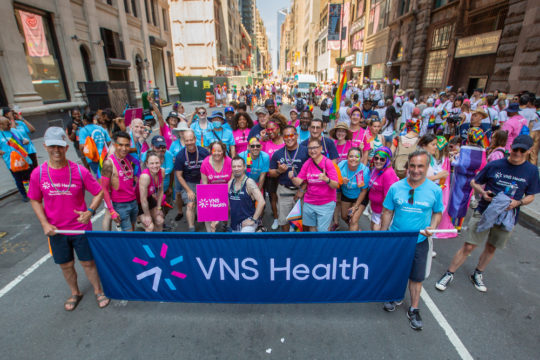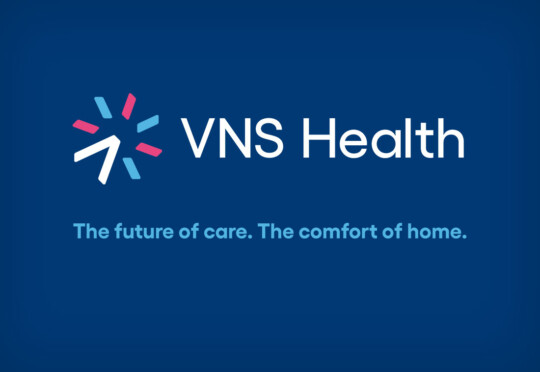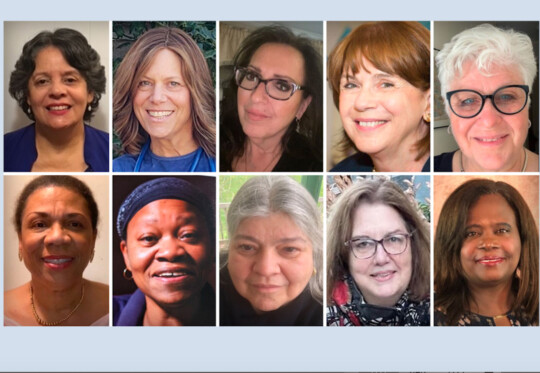Legendary Nurse Marilyn Liota Looks Back—Part 4: The 1990s and 2000s

Marilyn in 2008 with Mary Farren, Wound Ostomy Continence Nurse Specialist (on left) and Yael Reich, Diabetes Nurse Specialist.
To celebrate VNSNY’s 125th anniversary, Frontline VNSNY is publishing a four-part reminiscence by legendary former VNSNY nurse, Marilyn Liota. During her six decades at VNSNY, from 1952 to 2012, Marilyn rose from a field nurse to become the Regional Administrator and Vice President for Home Care in Queens. During this time, she saw incredible changes, both in New York City’s patient population and at VNSNY.
As you read these installments, we invite you to submit any questions you might have for Marilyn. Her replies will be posted as a special feature during National Nurses Week. Your questions can be emailed to Michael Delaney.
In this final installment, Marilyn recalls working for VNSNY in the 1990s and 2000s, as the organization continued to add new capabilities to meet the needs of an evolving healthcare landscape.
VNSNY in the 1990s and 2000s: The Organization Continues to Diversify
Following FDA approval of the first HIV/AIDS drug in 1987, the disease’s survival rates began to rise. By the late 1980s, VNSNY was providing care to an average of 600 HIV/AIDS patients on a daily basis—a number that would double by 1993. While new infections among adults continued to be an issue during the 1990s, the prevalence of children with AIDS declined significantly over that time, says Marilyn, “as people realized the risk of transmitting AIDS through pregnancy and began taking precautions.”

“We always took care of anyone, with any condition,” says Marilyn. “We did not discriminate.”
VNSNY’s staff was also impacted by a major change in Medicare procedure during this period, as the government insurer shifted to reimbursements based on diagnostic related grouping, rather than by treatment. “That was big—we all had to learn about that,” says Marilyn. The passage in 1990 of the Americans With Disabilities Act, which prohibited discrimination based on an individual’s disability, was another watershed, since the law made it easier for VNSNY’s caregivers to help individuals with various medical conditions—including AIDS—access needed resources. One thing the law did not impact, Marilyn adds, was VNSNY’s approach to its own patients and clients, which was always highly democratic. “We always took care of anyone, with any condition,” she says. “We did not discriminate.”
 Marilyn had taken over the leadership of VNSNY Acute Care’s Queens regional office in 1987, and her job now included a strong focus on supporting the Queens workforce. “I did a lot with staff development, which is something I really love to do,” she says. “I felt that my staff had quite a bit to offer, particularly since they represented so many different cultures.” One benefit of this growing diversity was that VNSNY’s frontline clinicians were frequently able to converse with non-English speaking patients in their own languages. “Still, you can’t always rely on that, so we also hired individuals from the community to serve as interpreters,” Marilyn recalls.
Marilyn had taken over the leadership of VNSNY Acute Care’s Queens regional office in 1987, and her job now included a strong focus on supporting the Queens workforce. “I did a lot with staff development, which is something I really love to do,” she says. “I felt that my staff had quite a bit to offer, particularly since they represented so many different cultures.” One benefit of this growing diversity was that VNSNY’s frontline clinicians were frequently able to converse with non-English speaking patients in their own languages. “Still, you can’t always rely on that, so we also hired individuals from the community to serve as interpreters,” Marilyn recalls.
 As the 21st century got underway, VNSNY was continuing to diversify as an organization as well. “The biggest change in the 2000s was that we went to a structure where we had separate departments for our social workers, for rehabilitation therapists and for long-term care,” says Marilyn. Another significant shift at that time, she notes, involved new regulations that allowed pharmacies and medical equipment companies to advertise directly to consumers. As a result of this and other changes such as improved access to healthcare information through the Internet and other sources, “people were becoming more independent in determining the direction of their own health care,” Marilyn notes.
As the 21st century got underway, VNSNY was continuing to diversify as an organization as well. “The biggest change in the 2000s was that we went to a structure where we had separate departments for our social workers, for rehabilitation therapists and for long-term care,” says Marilyn. Another significant shift at that time, she notes, involved new regulations that allowed pharmacies and medical equipment companies to advertise directly to consumers. As a result of this and other changes such as improved access to healthcare information through the Internet and other sources, “people were becoming more independent in determining the direction of their own health care,” Marilyn notes.

A VNSNY clinician makes a behavioral health home visit in 2010.
By the time Marilyn retired in 2012 after a 60-year career as a visiting nurse, program manager and later Queens regional vice president for VNSNY, new waves of immigrants had reshaped New York City’s ethnic landscape, and VNSNY had also evolved into a very different organization: It had grown dramatically over the years and become much more specialized, with a field staff that came to include rehabilitation therapists, social workers, home health aides, mental health workers and interdisciplinary hospice teams. Marilyn sees this evolution as a natural outgrowth of VNSNY’s mission. “We’ve always moved forward,” she says. “To be receptive to the community’s needs, you need to be embrace change.”
 Looking back now on her sixty years with VNSNY, Marilyn sees a New York City that has become ever more diverse, and an organization that has diversified with it. “Today, the borough of Queens has the largest multiethnic community in the world,” she says. “To be able to deal with such disparate groups is quite a challenge, and I think VNSNY does that more effectively than any organization anywhere. We take care of people in their homes. That means we can’t ever separate those we’re caring for from their communities and their daily lives. What has made VNSNY special over the years is our flexibility and our philosophy of caring—our ability to keep moving forward, and continually develop new programs that are responsive to community needs. That, to me, is VNSNY in a nutshell.”
Looking back now on her sixty years with VNSNY, Marilyn sees a New York City that has become ever more diverse, and an organization that has diversified with it. “Today, the borough of Queens has the largest multiethnic community in the world,” she says. “To be able to deal with such disparate groups is quite a challenge, and I think VNSNY does that more effectively than any organization anywhere. We take care of people in their homes. That means we can’t ever separate those we’re caring for from their communities and their daily lives. What has made VNSNY special over the years is our flexibility and our philosophy of caring—our ability to keep moving forward, and continually develop new programs that are responsive to community needs. That, to me, is VNSNY in a nutshell.”

Marilyn with Michele Nation-Cupid, Assistant to the Regional Vice President for Home Care in Queens.
Got a question for Marilyn? We invite you to submit any questions you might have for Marilyn. Your inquiries will be passed along to her, and Marilyn’s replies will be posted as a special feature at the end of this series during National Nurses Week. Your questions can be emailed to Michael Delaney.

From Marilyn’s collection of VNSNY pins (clockwise from left): The oval ID pin worn by VNSNY nurses in the 1950s, adapted from the original VNSNY nurses’ hats by famed fashion designer Lily Daché; a circular pin with the Chinese symbol “Brotherhood of Man,” developed by Lillian Wald and worn by VNSNY nurses starting in the early 20th century; a red VNSNY pin, introduced along with the redesigned VNSNY nurses’ uniforms in the 1970s; a pin produced to mark VNSNY’s centennial in 1993 that incorporates its current logo.
To read Part 5: Marilyn Answers Your Questions in our Marilyn Liota series, please click here.


